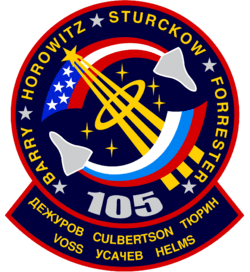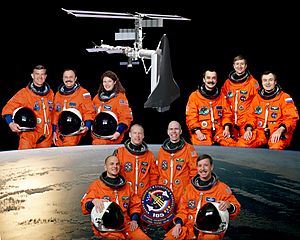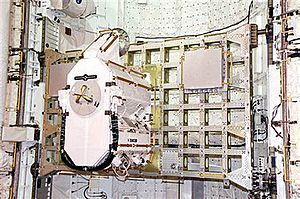STS-105 facts for kids

Aft view of the ISS from the departing Discovery
|
|
| Mission type | ISS crew rotation/logistics |
|---|---|
| Operator | NASA |
| Mission duration | 11 days, 21 hours, 13 minutes, 52 seconds |
| Spacecraft properties | |
| Spacecraft | Space Shuttle Discovery |
| Launch mass | 116,914 kilograms (257,751 lb) |
| Landing mass | 100,824 kilograms (222,279 lb) |
| Payload mass | 9,072 kilograms (20,000 lb) |
| Crew | |
| Crew size | 7 |
| Members |
|
| Launching |
|
| Landing |
|
| EVAs | 2 |
| EVA duration | 11 hours, 45 minutes |
| Start of mission | |
| Launch date | 10 August 2001, 21:10:14 UTC |
| Launch site | Kennedy LC-39A |
| End of mission | |
| Landing date | 22 August 2001, 18:23 UTC |
| Landing site | Kennedy SLF Runway 15 |
| Orbital parameters | |
| Reference system | Geocentric |
| Regime | Low Earth |
| Perigee | 373 kilometres (232 mi) |
| Apogee | 402 kilometres (250 mi) |
| Inclination | 51.6 degrees |
| Period | 92.3 minutes |
| Docking with ISS | |
| Docking port | PMA-2 (Destiny forward) |
| Docking date | 12 August 2001 18:41 UTC |
| Undocking date | 20 August 2001 14:51 UTC |
| Time docked | 7 days, 20 hours, 9 minutes |
  Left to right. Centre group: Sturckow, Forrester, Barry, Horowitz. Top left (Expedition 2): Voss, Usachev, Helms. Top right (Expedition 3): Tyurin, Culbertson, Dezhurov |
|
STS-105 was a space mission by the Space Shuttle Discovery. It launched from Kennedy Space Center, Florida, on August 10, 2001. The main goal of this mission was to visit the International Space Station (ISS).
This was Discoverys last flight for a while. The shuttle was taken out of service for upgrades. Later, all Space Shuttles were grounded after the Columbia accident. Discovery received a new "glass cockpit" during its upgrades. This is a modern flight deck with digital screens.
Contents
Meet the Crew of STS-105
The STS-105 mission had a team of seven astronauts. Four astronauts flew up on Discovery. Three astronauts from the International Space Station returned to Earth with Discovery.
| Position | Launching Astronaut | Landing Astronaut |
|---|---|---|
| Commander | Fourth and last spaceflight |
|
| Pilot | Second spaceflight |
|
| Mission Specialist 1 | First spaceflight |
|
| Mission Specialist 2 | Third and last spaceflight |
|
| Mission Specialist 3 | Expedition 3 Third and last spaceflight ISS Commander |
Expedition 2 Fourth and last spaceflight ISS Commander/ISS Soyuz Commander |
| Mission Specialist 4 | Expedition 3 First spaceflight ISS Flight Engineer |
Expedition 2 Fifth and last spaceflight ISS Flight Engineer |
| Mission Specialist 5 | Expedition 3 Second and last spaceflight ISS Soyuz Commander |
Expedition 2 Fifth and last spaceflight ISS Flight Engineer 2 |
Space Walks During STS-105
Astronauts Daniel T. Barry and Patrick G. Forrester performed two spacewalks. These spacewalks were important for working on the International Space Station.
- Barry and Forrester – EVA 1
- EVA 1 Start: August 16, 2001 – 1:58 PM UTC
- EVA 1 End: August 16, 2001 – 8:14 PM UTC
- Duration: 6 hours, 16 minutes
- Barry and Forrester – EVA 2
- EVA 2 Start: August 18, 2001 – 1:42 PM UTC
- EVA 2 End: August 18, 2001 – 7:11 PM UTC
- Duration: 5 hours, 29 minutes
Mission Goals and Highlights
The main purpose of STS-105 was to change out the crew on the International Space Station. It also delivered important supplies and equipment. The mission used a special cargo module called Leonardo. This module was built in Italy.
Leonardo carried many items for the space station. It brought new science racks for the station's U.S. laboratory, Destiny. These racks, called EXPRESS Racks 4 and 5, helped the astronauts do more experiments. EXPRESS stands for "Expedite the Processing of Experiments to the Space Station."
The module also carried storage racks and platforms. These were filled with bags of equipment and supplies. In total, Leonardo brought over 4,990 kilograms (about 11,000 pounds) of cargo to the ISS.
Another important item in the shuttle's cargo bay was the Integrated Cargo Carrier (ICC). It held the Early Ammonia Servicer. It also carried the Materials International Space Station Experiments (MISSE).
Testing Materials in Space
The MISSE project was a special experiment. It tested how different materials act in space. Scientists wanted to see how space conditions, like radiation and extreme temperatures, affected them. This helps engineers choose the best materials for future spacecraft.
The MISSE experiments were placed outside the ISS. They were carried in special containers called Passive Experiment Containers (PECs). These PECs are like suitcases that open up in space to expose the experiments.
Other Experiments
STS-105 also carried other smaller experiments. These included:
- Simplesat, a small satellite experiment.
- The Cell Growth in Microgravity experiment.
- The Microgravity Smoldering Combustion experiment.
- The Hitchhiker Experiment Advancing Technology Space Experiment Module-10.
These experiments helped scientists learn more about how things behave in the microgravity of space.
Launch Details
The launch of STS-105 happened on August 10, 2001. It was a successful launch. Interestingly, this was the only Space Shuttle launch that happened at the very beginning of its launch window. This means it launched earlier than usual. The reason was that a storm was approaching. Launch control wanted to get Discovery into space before the bad weather arrived.
Wake-up Calls for Astronauts
NASA has a fun tradition of playing music to wake up astronauts in space. This started during the Gemini program and was first used during the Apollo 15 mission. Each song is chosen carefully. Often, the astronauts' families pick the songs. The music usually has a special meaning to an astronaut or relates to their work that day.
| Flight Day | Song | Artist/Composer | Links |
|---|---|---|---|
| Day 2 | "Back in the Saddle Again" | Gene Autry | wav mp3 Transcript |
| Day 3 | "The White Eagle" | traditional Russian folk song | wav mp3 [Transcript] |
| Day 4 | Overture from The Barber of Seville | Rossini | wav mp3 Transcript |
| Day 5 | "Arthur's Theme" (Best That You Can Do) | Christopher Cross | wav mp3 Transcript |
| Day 6 | "Big Boy Toys" | Aaron Tippin | wav mp3 Transcript |
| Day 7 | "The Marvelous Toy" | Tom Paxton | wav mp3 Transcript |
| Day 8 | "Time Bomb" | Patrick and Andrew | wav mp3 Transcript |
| Day 9 | "Hotel California" | The Eagles | wav mp3 Transcript |
| Day 10 | "Under the Boardwalk" | The Drifters | wav mp3 Transcript |
| Day 11 | "Brand New Day" | Sting | wav mp3 Transcript |
| Day 12 | "East Bound and Down" | Jerry Reed | wav mp3 Transcript |
| Day 13 | "Again" | Lenny Kravitz | wav mp3 Transcript |
Images for kids
See also
 In Spanish: STS-105 para niños
In Spanish: STS-105 para niños






